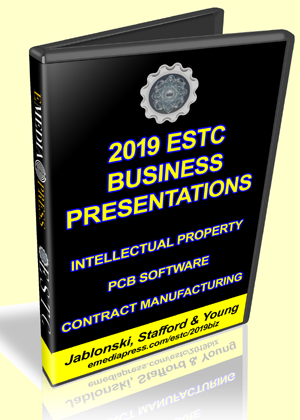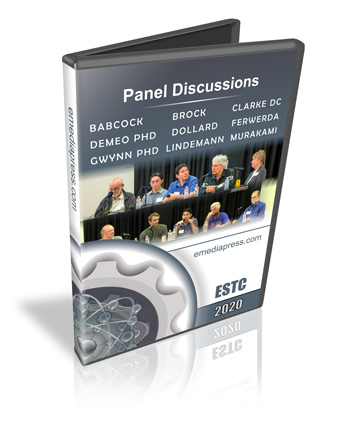
Here are three presentations that will answer many questions relating to Intellectual Property protection, Circuit Board creation and Contract Manufacturing from experts in their own respective fields.
These presentations are comprehensive and will walk you through the whole topic and they end with some Q & A.
You can get each video separately or you can get all three of them at a discount.
Get copies here: https://emediapress.com/shop/combo-intellectual-property-protection-pcb-software-contract-manufacturing/
INTELLECTUAL PROPERTY PROTECTION
Protecting your inventions is an imporant consideration depending on your goals. If you have an invention and want to be able to earn money from it commercially, you may or may not want to file for a patent. Before deciding what you want to do, it is highly recommended to at least look at your options by hearing from a qualified Intellectual Property attorney who was also one of John Bedini’s attroneys at EnergenX. Kevin helped them to secure patents for them in the field of battery charging efficiency and EMF recovery.
There are pros and cons to patenting and this presentation will shine light on many of your blindspots when it comes to this topic. There are also many misconceptions that people in the “open source” and alternative energy field have that need to be corrected as well. It is also possible to file for a patent yourself so you need to consider all the facts in order to determine whether or not you want to do that or if you want to hire an expert.
If you’re involved with any kind of disruptive technology, you should definitely consider hiring an attorney to help you with this if you want to patent it because there are ways to get the patent granted or at least have the best chance of doing so and the language is all important. If Kevin Jablonski can help John Bedini get a patent on his energy recovery circuits, then you can see the value of having someone like this on your own team to help you protect your valuable inventions.
Get copies here: https://emediapress.com/shop/combo-intellectual-property-protection-pcb-software-contract-manufacturing/
PCB SOFTWARE
If there is a circuit board as part of your invention, you will need to know about PCB Software so you can create the right kind of files to provide to a PCB company so they can manufacture them for you. This can be intimidating for the beginning who has only made circuits on breadboards or their own univesal soldering boards.
When I first had the Bedini RPX Sideband Generator manufactured, I printed the PCB file as an iron-on transfer, which I put on copper boards. Then I etched them in a chemical solution, cleaned them off and then dipped them in a highly toxic tinning solution, which allows the solder to stick to the traces more easily. It worked, but it was an experience that taught me one lesson – that is exactly what I do NOT want to do!
It was a valuable lesson for me as part of the overall manufacturing process but there is a much simpler way. The program I used was and still is Kicad, a free, open source software program that is more robust than even some paid programs. It has its quirky parts, but it works perfect. It took me a while to learn how to use it because I didn’t use any tutorials and taught myself by trial and error. Most of the tutorials I saw on YouTube and elsewhere were usually assuming I already knew how to use the program, which wasn’t helpful at all.
RS Stafford, who has many years experience with PCB programs learned Kicad in a matter of days and knew it better than I did with months of experience with it. Having the “schema” or frame of reference for what these programs are supposed to do was most likely very helpful in cutting down his learning curve.
In this presentation, RS walks you through the creation of a circuit step-by-step so you know exactly how to do it. He uses one or two example circuits that many of you will be familiar with and he shows how to export this to Gerber files, which are what you want to provide a company if you want multiple boards created for you. Take my advice, forget about the DIY method of etching your own boards, etc. it isn’t worth the time. If you want to do that just to have the experience, that is one thing but you will never keep up on the demand if you’re serious about selling a significant amount of your circuits.
Get copies here: https://emediapress.com/shop/combo-intellectual-property-protection-pcb-software-contract-manufacturing/
CONTRACT MANUFACTURING
If you plan on offering your invention(s) to the public, you build them all yoursef if you plan to do small quantity, but if you want to have a life where you aren’t owned by the building process like so many small-time inventors, you will absolutely want to learn about contract manufacturing.
My first experience with contract manufacturing was when I initially made the Bedini RPXs available. At first, I built the first 25 myself. They worked, but since I drilled out the holes in the cases by hand, they weren’t all 100% aligned, the sticker labels looked so-so, they worked perfect, but it was so time-consuming! After that first batch, I learned another lesson, besides etching my own PCBs, I aboslutely did NOT want to manufacture these devices. Again, I can have a life or be consumed by building things. I enjoy building but more when it is experimental research on the bench, but working my own assembly line – forget about it.
Paul Babcock referred me to a local contract manufacturer since he knows the whose who in that business here in Spokane. I made an appointment, showed them what I wanted to accomplish and they guided me in the process of what I needed to provide to them so they could do it all. There is an option for them to do as much or as little as desired. I chose to do it “turn-key” meaning that I just submit the order for how many I want and they do 100%. They order every piece, they order the PCBs, they did all the assembly exactly to my spec, you name it.
In four weeks (with an expedited fee) or six weeks of normal lead time, they have 125-150 units all brand new and waiting in a box for me to pick up. They even test each unit with a scope and spectrum analyzer I let them borrow for a few days according to the exact protocols John Bedini used. They’ll even pack the units in boxes with the signal generators, batteries, and cables if I want with the only thing needed is a customer address label stuck to the box.
The greatest thing about all of this is that I learned I can do this at affordable pricing right here in Spokane so I don’t have to outsource antything overseas! 100% Made in Spokane for a reasonble price. It doesn’t get any better than that.
In this presentation, Seth Young who is with a Contract Manufacturer that specializes in sheet metal fabrication (they made the cases for our MWO Pulse Modulators) gives an overview with a lot of information on the process. Although you may or may not need sheet metal fabrication, the concepts apply to any kind of contract manufacturing and what you can expect or know to ask for.
Get copies here: https://emediapress.com/shop/combo-intellectual-property-protection-pcb-software-contract-manufacturing/


